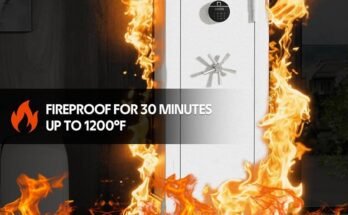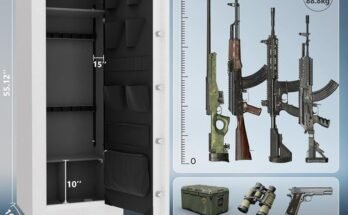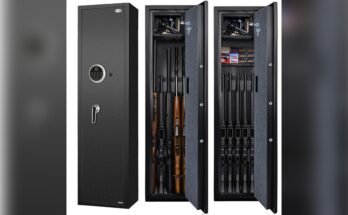You’ve invested in a fireproof rifle safe to protect your valuable firearms from fire damage. But have you ever stopped to wonder if the electronic lock on your safe will still work when it matters most?
Your safety and access depend on this critical detail. You’ll discover the truth about how electronic locks perform under extreme heat and what you can do to ensure your safe stays secure—and accessible—when disaster strikes. Keep reading to find out if your electronic lock is truly up to the challenge.
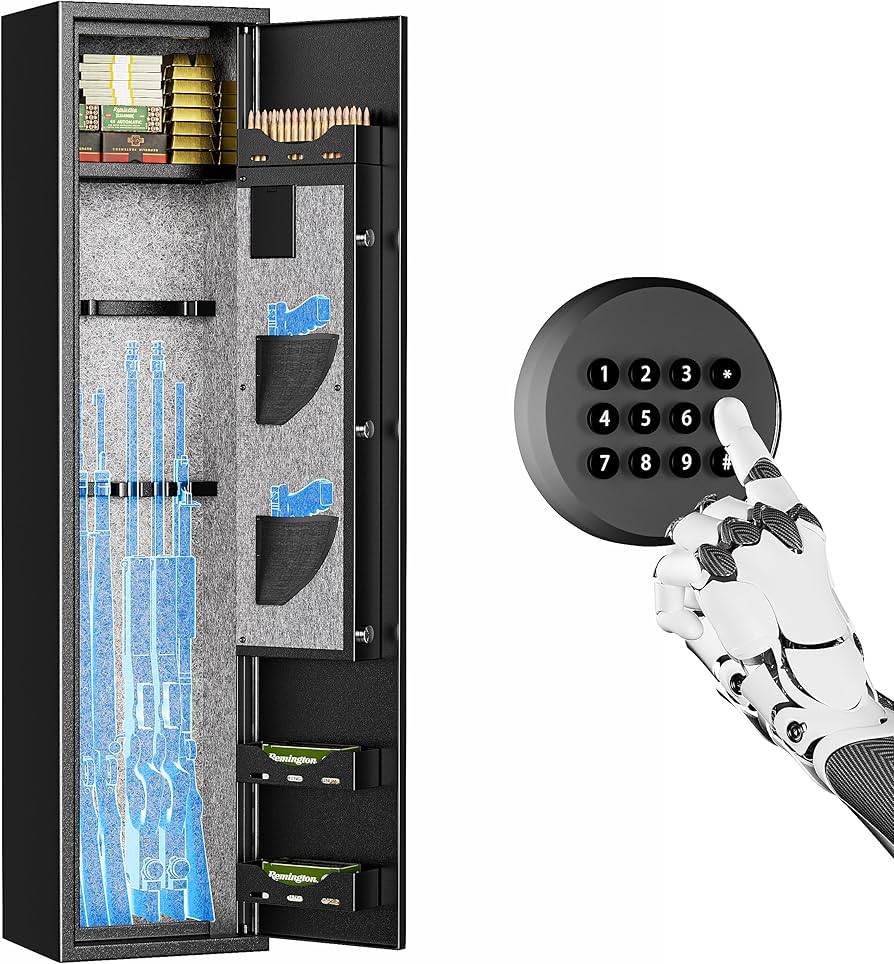
Fireproof Rifle Safes Basics
Fireproof rifle safes protect your firearms from fire damage and theft. They combine strong materials and smart design. Understanding the basics helps you choose the right safe for your needs.
Fireproof safes use special insulation to keep heat out. This keeps guns and important items inside safe during a fire. The safe’s locking system also plays a key role in security.
Key Features Of Fireproof Safes
Fireproof safes are made with thick steel and fire-resistant insulation. They have tight seals to keep smoke and heat out. Many safes include humidity control to protect metal parts. Locks can be mechanical or electronic. Good safes are heavy and hard to move.
Importance Of Fire Resistance
Fire resistance means the safe can withstand high heat for a set time. This time is rated in minutes or hours. The longer the rating, the better the protection. Fire resistance stops heat from damaging guns and ammo. It also helps keep paper documents and electronics safe inside.

Types Of Electronic Locks
Electronic locks offer different ways to secure a fireproof rifle safe. Each type has unique features. Understanding these helps choose the right lock for safety and ease of use.
These locks combine technology with security. They often provide faster access than traditional keys. Some work better in emergencies or harsh conditions.
Keypad Locks
Keypad locks use a set of numbers to open the safe. Users enter a code on a small keypad. This method is simple and common.
Keypad locks do not require physical keys. This reduces the risk of losing access. Codes can be changed easily for better security.
These locks work well in fireproof safes. Most keypad systems resist heat and flames. They keep the safe secure even in a fire.
Biometric Locks
Biometric locks use fingerprints or other body features. They provide quick and personal access. Only registered users can open the safe.
This technology adds strong security. It is hard to copy or steal fingerprints. Biometric locks often include backup options.
They perform well in fireproof safes. The sensors are designed to withstand heat. This keeps your rifle safe and accessible.
Rfid And Bluetooth Locks
RFID and Bluetooth locks use wireless signals. RFID works with a key card or tag. Bluetooth connects to a smartphone app.
These locks offer convenience and speed. No need to remember codes or use keys. Access is controlled through devices you carry.
They are built to resist fire damage. The electronics inside fireproof safes are protected. These locks provide secure, quick entry in emergencies.
Heat Impact On Electronic Locks
Electronic locks in fireproof rifle safes face extreme heat during a fire. Understanding how heat affects these locks helps you know their safety limits. Heat can damage electronic parts and affect lock performance.
Temperature Tolerance Levels
Electronic locks usually handle temperatures up to 140°F (60°C). Beyond this, internal circuits may overheat. Most fireproof safes keep heat low inside, but extreme fires can raise temperatures quickly. Some locks have heat-resistant parts to delay damage. Still, prolonged exposure to high heat reduces lock reliability.
Potential Failure Points
Heat can harm batteries, wiring, and circuit boards in electronic locks. Batteries may leak or stop working under high heat. Wiring insulation can melt, causing short circuits. Circuit boards may warp or crack, stopping the lock from working. Buttons and screens can also fail due to heat. These failures make opening the safe difficult after a fire.
Fire Testing Standards
Fire testing standards help prove if electronic locks work during a fire. These tests check how well locks and safes protect guns and valuables. They measure heat resistance and lock durability under fire stress. Understanding these standards gives confidence in safe performance and security.
Ul And Etl Certifications
UL and ETL are trusted companies that test fireproof safes. UL stands for Underwriters Laboratories. ETL means Electrical Testing Laboratories. Both test safes for heat resistance and lock strength. Their certifications show a safe meets set fire safety rules. Certified safes protect contents longer in fires. Electronic locks inside these safes face strict testing. Passing means they keep working despite high heat.
Fireproof Safe Ratings
Fireproof safes have ratings that show their fire resistance. Ratings include time and temperature levels they can handle. Common ratings are 30 minutes, 1 hour, or 2 hours of fire exposure. The temperature rating tells how hot the safe can get inside. Lower internal temperatures mean better protection for guns and electronics. Ratings help buyers choose safes based on fire risk and needs. Electronic locks must meet these ratings to stay reliable during fires.
Battery Life And Power Issues
Battery life and power issues play a big role in the safety of electronic locks in fireproof rifle safes. These locks depend on batteries to work. If the battery dies or fails during a fire, the lock might not open. This makes understanding battery performance and backup options very important for gun owners. Knowing what can happen to batteries in high heat and how to prepare for power failures helps keep firearms secure and accessible.
Battery Performance In High Heat
Batteries often lose power faster in high temperatures. Fireproof safes can get very hot inside during a fire. This heat can reduce battery life quickly. Some batteries may even stop working entirely. Electronic locks might fail to respond if the battery is weak from heat damage. This risk makes it important to choose locks with batteries designed for heat resistance. Regular battery checks can also help find early problems before an emergency.
Backup Power Solutions
Many electronic locks include backup power options. External battery packs or emergency power inputs keep locks working when main batteries fail. Some models have mechanical keys as a last resort. Backup power ensures access even if the primary battery dies. It is wise to test backup systems regularly. Having more than one power source adds safety during power loss. Backup solutions make electronic locks more reliable under extreme conditions.
Security Vs. Fire Safety
Choosing a fireproof rifle safe means thinking about two key factors: security and fire safety. Both are important for protecting your valuables. Electronic locks offer strong security but may face challenges in extreme heat. Understanding how these locks perform during a fire helps you make the right choice.
Balancing Lock Security And Fire Durability
Electronic locks provide quick access and strong protection against theft. They use batteries and digital parts, which can be sensitive to heat. Fireproof safes are built to resist high temperatures for a certain time. But electronic locks may fail if the heat is too intense or lasts too long.
Manufacturers test safes for fire resistance, including the lock’s durability. Some models use special materials to protect electronic components. This balance ensures the safe stays locked during a fire and keeps your items secure.
Common Misconceptions
Many believe electronic locks stop working in fires instantly. This is not always true. Quality fireproof safes often protect the lock’s electronics well enough to function after a fire.
Another myth is that mechanical locks are better in fires. Mechanical locks can also fail if exposed to extreme heat for a long time. The key is choosing a safe tested for both security and fire resistance.
Expert Recommendations
Experts stress careful choices and upkeep for electronic locks in fireproof rifle safes. These steps ensure safety and lock durability. Proper knowledge helps keep your valuables secure during emergencies.
Choosing The Right Lock Type
Select a lock designed to endure high heat. Look for locks with fire resistance ratings. Mechanical locks often perform better under extreme heat than electronic ones. Consider locks with backup power options. This ensures access if batteries fail during a fire. Choose models with tamper alarms to enhance security. Verify the lock fits your safe model perfectly.
Maintenance Tips For Electronic Locks
Regularly test the lock to confirm proper function. Replace batteries every six months to avoid power failure. Clean the keypad gently to prevent dirt buildup. Keep the lock dry and free from rust. Update lock codes periodically for security. Follow manufacturer instructions closely for maintenance. Promptly repair or replace faulty locks to maintain safety.
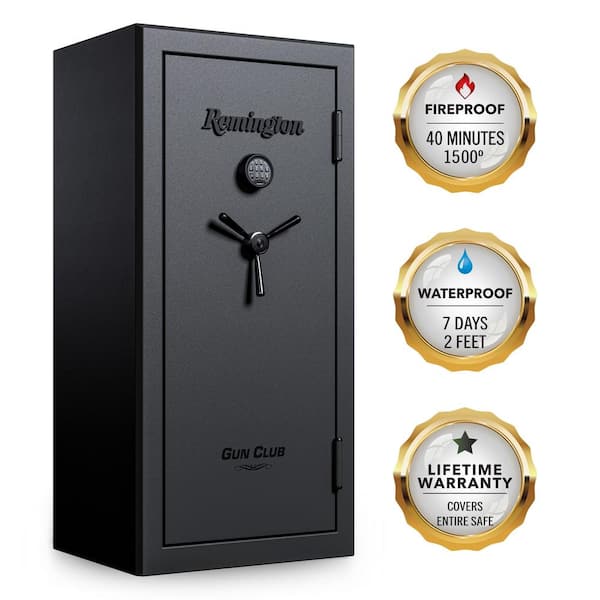
Real-world Fire Incidents
Fireproof rifle safes are designed to protect contents during a fire. Many use electronic locks for quick access. But how do these locks perform in real fires? Understanding real incidents helps reveal their reliability.
Fires create extreme heat that can damage lock mechanisms. Electronic locks rely on batteries and circuits. High temperatures may cause these parts to fail. Real cases provide insight into what happens under fire stress.
Case Studies Of Electronic Locks In Fires
In one case, a fire engulfed a home with a fireproof safe. The electronic lock failed to respond after the fire. The owner had to wait for a locksmith to open it. Despite the fireproof rating, the lock’s electronics were damaged.
Another incident showed a safe surviving a fire with the lock still working. The battery was fresh and the electronics stayed intact. The safe’s design included extra insulation around the lock. This case showed how some electronic locks can resist fire damage.
Lessons Learned
Electronic locks need proper protection from heat inside safes. Battery life and quality affect lock performance during fires. Regular battery checks are essential for safety.
Safe design matters. Insulation around the lock helps keep it cool. This prevents electronic failure. Mechanical backup options are wise. They provide access if electronics fail.
Choosing a fireproof safe with tested electronic locks improves chances of success. Understanding past fire incidents guides better safe choices. It also highlights the need for maintenance and smart use.
Frequently Asked Questions
Are Electronic Locks Reliable During A Fire Emergency?
Electronic locks in fireproof rifle safes are designed to withstand heat. However, extreme temperatures may affect their functionality temporarily. Most models include backup mechanical keys for emergencies. Always verify lock specifications to ensure fire resistance and operational reliability during fire incidents.
How Long Can Electronic Locks Endure High Temperatures?
Electronic locks in fireproof safes typically endure high temperatures for 30 to 60 minutes. This duration aligns with common fireproof rating standards. Prolonged exposure to intense heat may damage electronic components. Choosing safes with tested fire ratings ensures better lock durability under fire conditions.
Do Electronic Locks Require Special Maintenance For Fire Safes?
Yes, electronic locks need regular maintenance to ensure fire safety. Clean and check batteries periodically to prevent failure during emergencies. Inspect seals and lock mechanisms for damage. Proper upkeep increases the lock’s reliability and ensures it functions correctly when exposed to heat.
Can Fire Affect The Battery Life Of Electronic Locks?
Fire exposure can reduce battery life or damage electronic lock circuits. Heat may cause batteries to drain faster or fail completely. Using high-quality, heat-resistant batteries and backup power options can improve lock performance during a fire. Always keep spare batteries accessible for emergencies.
Conclusion
Electronic locks can work well in fireproof rifle safes. They offer quick access and good security. Still, consider battery life and heat resistance carefully. Choose locks tested to handle high temperatures. Regularly check and maintain your lock’s function. This keeps your valuables both safe and easy to reach.
Trust your safe to protect what matters most. Safety and convenience can go hand in hand.

